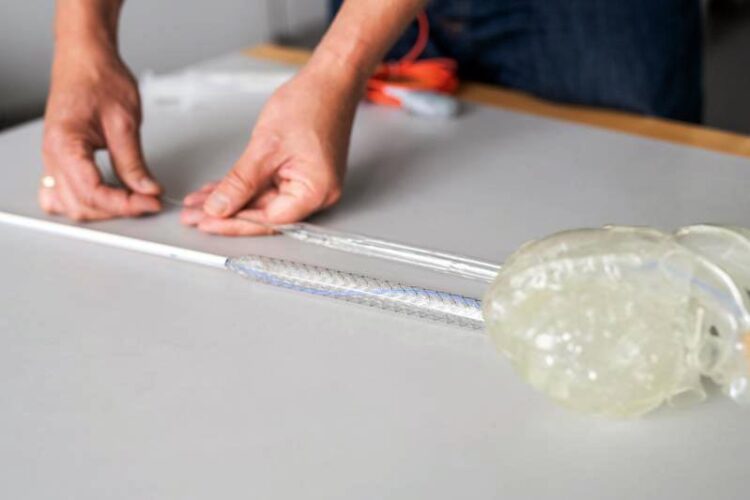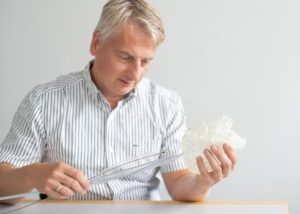Research with heart saves human lives

The right heart pump can be implanted via the leg vein at the beating heart.
© Fr. Nürnberger / Erfurt (Germany)
Researchers and entrepreneurs from Jena are winning hearts – literally. Together with the start-up NovaPump from Jena and the Jena University Hospital, the Fraunhofer Institute for Applied Optics and Precision Engineering IOF has developed innovative heart valves and pumps. On the occasion of World Heart Day on September 29, we look back on the history of a long-standing and cordial cooperation.

© Fr. Nürnberger / Erfurt (Germany)
The human heart performs extraordinary feats day after day. It supplies tissues and organs with the necessary amount of oxygen and removes harmful substances. Every minute, it pumps the entire blood through the body once. Under stress, it even does so up to five times and continues to do so ideally for many decades. If the heart gets out of sync or can no longer perform as required due to illness, specialists like Dipl.-Ing. Ronald Reich and Prof. Dr. Dr. Markus Ferrari from NovaPump GmbH and Dr. Thomas Peschel from Fraunhofer IOF are needed to restore synchronization.
All three have been involved in the development of highly efficient implants for weakened hearts for many years, in close scientific collaboration with the Department of Internal Medicine I at Jena University Hospital. Together with the team of clinic director Prof. Dr. Christian Schulze, as well as his predecessor Prof. Dr. Hans-Reiner Figulla, they have repeatedly worked closely together in the past to develop various therapeutic solutions – most recently in two public projects funded by the German Federal Ministry of Education and Research (BMBF) to realize innovative right and left heart pumps. These are inserted via the leg vessels to the heart in acute patients in the catheter laboratory while the heart is still beating. Temporarily, these self-expanding heart pumps can provide effective pumping support for a few days until further diagnostic and therapeutic measures are taken and the weakened heart muscle has recovered. The development of these innovative heart pumps is based on a long-standing cooperation between researchers and entrepreneurs from Jena, which goes back to the 1990s.
Longstanding cooperation produces diverse heart implants
Since 1998, Dr. Thomas Peschel has been researching various implants for the heart, in addition to many other things at Fraunhofer IOF. His work in this field began with the development of an artificial heart valve. The heart valve includes a vascular support, also called a “stent”. Together with a team of researchers from Fraunhofer IOF and physicians from the University Hospital of Jena, Peschel developed a prosthesis that can be placed at the site of the damaged heart valve without major surgery.
This technology is an innovative solution for elderly or weak patients in particular, as their health often does not permit extensive surgery on the open chest. What is special about the heart valve developed by Peschel and his team is that the valve does not unfold together with the stent until it is in place. After years of successful research, the idea was transferred into medical practice with the help of a spin-off company.
Simultaneously with Peschel’s research, the start-up NovaPump GmbH was founded in Jena. Its co-founder, Prof. Dr. Dr. Markus Ferrari, was involved in heart valve development on the part of Jena University Hospital. Together with his business partner Dipl.-Ing. Ronald Reich, now managing director of NovaPump GmbH, the two approached Thomas Peschel’s team at Fraunhofer IOF again in 2013 and inspired him with the idea of building on the experience of heart valve development to next develop novel self-expanding, pulsatile heart pumps.
A technology grows: from heart valves to heart pumps
For Peschel, this was an interesting new challenge: Together with NovaPump, he and his team first began working on a pump for the so-called right ventricle, or heart chamber. The right ventricle pumps deoxygenated blood toward the pulmonary circulation, where it is subsequently oxygenated in the lungs and pumped back into the body. “The right ventricle was very well suited to the idea of a novel self-expanding and catheter-based pulsatile heart pump. The pressure is lower than in the left side of the heart, and there is only one competitor system on the market today that is based on a pumping principle that is disadvantageous for patients,” the researcher explains. Just like the previously developed heart valves, the pump must be able to be folded to the smallest possible size to be transported to its place of use in the heart. Only once it arrives in the respective heart chamber does it begin to unfold itself in a defined manner due to the innovative material.
The NovaPump right heart pump uses innovative valves inside and a small balloon as a drive. It can be filled with helium in a fraction of a second and then deflated again – a classic positive displacement pump. In order to work flawlessly, the balloon needs an extremely stable support structure. This unfolds in the superior vena cava in such a way that the balloon is directly ready for use and can be activated via a control console that has proven itself in cardiac medicine for many years. To realize this extremely difficult undertaking, a special shape memory metal is used for the supporting structure of the heart pump. The pump cage is cut out of a thin metal tube with a laser and then further treated in such a way that it develops its required stability at body temperature and can nevertheless be explanted again via the leg vein in a catheter-based and folded manner after cardiac support has been provided.
“We want to save lives”
After successfully demonstrating the right heart pump in various test series, the team led by Peschel, Schulze, Reich and Ferrari then went on to develop another pump – this time for the left ventricle. After extensive research, they finally succeeded in finding the ideal design and material match for it to meet the anatomical requirements and pressures in the left ventricle.
NovaPump GmbH is now vigorously working on making these therapy systems available to acute patients worldwide. “We want to use them to save lives,” says Ronald Reich. “Our percutaneous heart pumps are to be used in particular in cases where acute cardiac events, e.g., a heart attack or cardiogenic shock, have occurred and the circulation needs to be stabilized and supported within minutes. Safe and complication-free handling of the pumps with maximum patient benefits is crucial in order to further reduce today’s still high mortality rate of up to 50 % after these acute events,” continues the CEO.
Wissenschaftliche Ansprechpartner:
Dr. Thomas Peschel
Fraunhofer IOF
Department Optical and Mechanical Design
Phone: +49 (0) 3641 807-335
E-mail: thomas.peschel@iof.fraunhofer.de
Weitere Informationen:
https://www.iof.fraunhofer.de/en/pressrelease/2022/innovative-heart-valves-pumps…
Media Contact
All latest news from the category: Medical Engineering
The development of medical equipment, products and technical procedures is characterized by high research and development costs in a variety of fields related to the study of human medicine.
innovations-report provides informative and stimulating reports and articles on topics ranging from imaging processes, cell and tissue techniques, optical techniques, implants, orthopedic aids, clinical and medical office equipment, dialysis systems and x-ray/radiation monitoring devices to endoscopy, ultrasound, surgical techniques, and dental materials.
Newest articles

Innovative 3D printed scaffolds offer new hope for bone healing
Researchers at the Institute for Bioengineering of Catalonia have developed novel 3D printed PLA-CaP scaffolds that promote blood vessel formation, ensuring better healing and regeneration of bone tissue. Bone is…

The surprising role of gut infection in Alzheimer’s disease
ASU- and Banner Alzheimer’s Institute-led study implicates link between a common virus and the disease, which travels from the gut to the brain and may be a target for antiviral…

Molecular gardening: New enzymes discovered for protein modification pruning
How deubiquitinases USP53 and USP54 cleave long polyubiquitin chains and how the former is linked to liver disease in children. Deubiquitinases (DUBs) are enzymes used by cells to trim protein…



